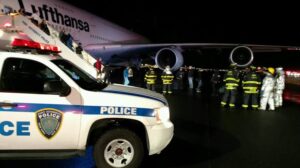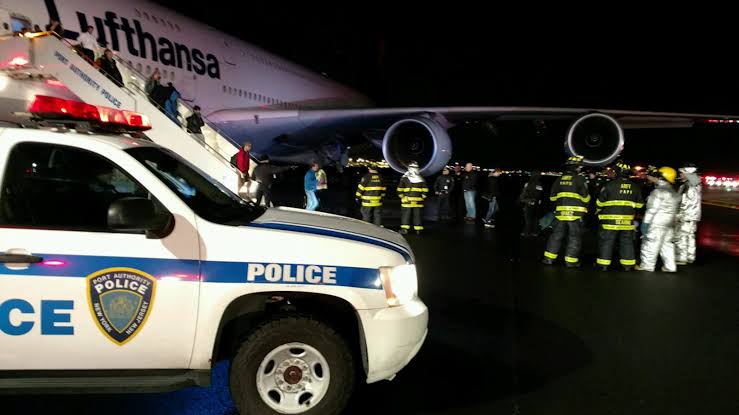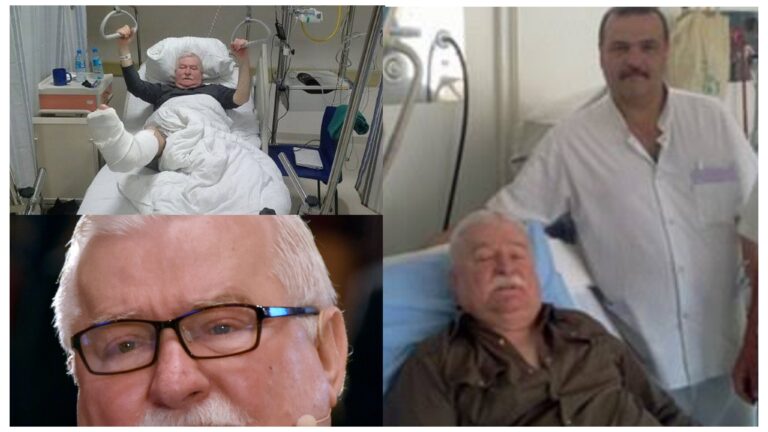Lufthansa Flight Diverted to JFK After Bomb Threat Sparks Emergency Landing
Lufthansa Flight Diverted to JFK After Bomb Threat Sparks Emergency Landing
In a harrowing mid-air incident that disrupted international air travel and heightened security concerns, Lufthansa Flight LH441 was forced to make an emergency landing at New York’s John F. Kennedy International Airport following a credible bomb threat. The flight, which had departed from Houston George Bush Intercontinental Airport and was bound for Frankfurt, Germany, was diverted mid-flight when authorities were alerted to a potential security threat on board.
The incident unfolded during the evening hours, sending shockwaves through both passengers and airline personnel, and prompting swift coordination between Lufthansa, the Federal Aviation Administration (FAA), the Transportation Security Administration (TSA), and law enforcement agencies.
The Flight and the Threat
Lufthansa Flight LH441, a Boeing 747-8, took off from Houston as scheduled with 530 passengers and 19 crew members aboard. About three hours into the transatlantic journey, Lufthansa’s operations center received a message from U.S. security officials indicating that a bomb threat had been made specifically referencing the flight.
Authorities have yet to disclose the exact nature of the threat—whether it was received via telephone, email, or another communication channel—but classified the threat as “credible,” prompting immediate action. The pilot was informed and ordered to divert to the nearest suitable major airport, which in this case was JFK in New York.
According to aviation protocols, any threat of this nature triggers a high-alert response, including security sweeps, passenger evacuations, and temporary airport shutdowns. Lufthansa’s pilot followed procedures diligently, coordinating with air traffic control and preparing the crew for emergency landing protocols.
Emergency Landing at JFK
At approximately 9:30 PM local time, Flight LH441 was cleared for an expedited landing on a remote runway at JFK, far from other active airport terminals. Emergency response units were already positioned at the airfield, including bomb squad units, fire engines, ambulances, and NYPD tactical response teams.
The aircraft landed safely and taxied to a secure area where it was immediately surrounded by law enforcement vehicles. A full-scale evacuation followed, with passengers asked to leave their personal belongings on board as they exited via mobile stairways rather than traditional jet bridges.

One passenger described the evacuation process as “tense but orderly.” “We were told there was a threat, and everyone cooperated. We didn’t know the details at the time, but the seriousness on the crew’s faces said it all,” said Eric Vasquez, a 41-year-old business traveler from Austin.
Security Sweep and Investigation
Once the aircraft was cleared of passengers and crew, the NYPD Bomb Squad, aided by federal agents, began a thorough search of the aircraft’s cabin, cargo hold, and lavatories. Bomb-sniffing K9 units were deployed, and all luggage was inspected separately in a secure facility. No explosives or suspicious devices were discovered during the sweep.
FBI agents were also on the scene and immediately launched an investigation to trace the origin of the bomb threat. Preliminary findings suggested the threat may have been a hoax, but officials were unwilling to rule out foul play until a full forensic analysis could be conducted.
The aircraft was eventually cleared and taken back to Lufthansa’s maintenance hangar for additional safety inspections before being returned to service.
Impact on Passengers and Airport Operations
Passengers were initially taken to a secure terminal at JFK where they were questioned individually by TSA agents and FBI investigators. Lufthansa provided accommodations for all travelers affected by the emergency landing, including hotel stays, meals, and rebooking on subsequent flights.
Many travelers praised Lufthansa’s response to the crisis, citing the professionalism of the crew and the efficiency of the evacuation process. “It was scary, especially when we saw all the emergency lights around us, but the Lufthansa staff kept us calm,” said Anna Schmidt, a German national returning home after a vacation in Texas.
Meanwhile, JFK experienced temporary delays, particularly on runways near the emergency landing site. Flights were held in the air or redirected to other gates while the bomb squad completed their inspection. The airport resumed normal operations by early morning.
Response from Lufthansa and Authorities
Lufthansa released a statement shortly after the incident:
> “Flight LH441 operating from Houston to Frankfurt was diverted to JFK International Airport as a precautionary measure following a security threat. The aircraft landed safely, and all passengers and crew disembarked without incident. We are cooperating fully with U.S. authorities to investigate the source of the threat. The safety of our passengers and crew is our top priority.”
The FAA and Department of Homeland Security also confirmed the incident and emphasized that appropriate measures had been taken in response to the threat. FAA spokesperson Kathryn Reynolds said, “Incidents like these are rare but taken extremely seriously. Safety is our primary concern, and all protocols were followed without error.”
Heightened Security Concerns
This event comes amid a broader backdrop of increased aviation security threats worldwide. Airlines and airports have been on heightened alert in recent years due to a surge in hoaxes, cyberattacks, and attempted disruptions. While most threats turn out to be false alarms, the cost of responding to them in both financial and logistical terms is immense.
Security experts noted that even a single threat can ground hundreds of flights and result in ripple effects across multiple airports. “One diverted aircraft affects more than just the passengers on that flight. Gate assignments shift, crews are delayed, and passengers on connecting flights miss departures. It’s a chain reaction,” said Dr. Marcus Eldridge, an aviation security analyst based in Washington, D.C.
Legal Consequences for Hoaxers
If the investigation confirms that the bomb threat was a hoax, those responsible could face severe legal consequences. Under federal law, making a false threat involving aircraft can result in up to 20 years in prison, significant fines, and civil liability for costs incurred during emergency response.
The FBI has not yet confirmed whether any suspects have been identified, but officials are pursuing digital forensic leads to trace the origin of the message.
Rebooking and Refunds
Lufthansa began rebooking affected passengers onto other flights later the same night and the following morning. Some travelers were placed on partner airlines under the Star Alliance network. Full refunds or alternate travel arrangements were offered to those who chose not to continue their journey immediately.
Passengers expressed a mix of relief and frustration—relief at being safe, and frustration at the disruption to their travel plans. “I lost a day of meetings in Frankfurt, but honestly, I’m just glad it wasn’t something worse,” said Patrick Duval, a French IT consultant.
Conclusion
The emergency landing of Lufthansa Flight LH441 at JFK serves as a stark reminder of the unpredictable nature of modern air travel and the challenges faced by airlines and security agencies in safeguarding passengers. While no explosives were found and no injuries occurred, the incident underscored the need for vigilance, rapid response, and continued investment in aviation security.
As investigators continue to probe the origins of the bomb threat, Lufthansa has resumed normal operations, and passengers are once again in the skies—reminded that safety remains the first and most critical priority at 35,000 feet.






